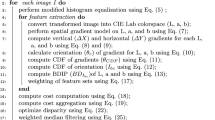Abstract—
The main assumption of classical stereo matching is that matching pixels in stereo images have the same brightness values. However, this assumption is generally incorrect if we take into account the presence of noise in the images and the different illumination of the left and right images of the stereo-pair. In addition, pixel-by-pixel mapping does not work in areas where there is no real texture. Therefore, it is important to develop and use robust local features based on a certain neighborhood of the pixels being matched. In this study, we have developed and proposed to use a completely new local feature based on the Walsh–Hadamard transform. The transform in a local 8 × 8 window is easily encoded into a 64-bit value comparable in Hamming distance. The accuracy of such matching surpasses the use of a robust census feature that is close to the principle. Moreover, combining both features allows us to achieve the best stereo matching for methods that are not based on deep learning schemes.


Similar content being viewed by others
REFERENCES
D. Scharstein and R. Szeliski, “A taxonomy and evaluation of dense two-frame stereo correspondence algorithms,” Int. J. Comp. Vision 47 (1–3), 7–42 (2002).
E. Ershov, V. Karnaukhov, and M. Mozerov, “Probabilistic choice between symmetric disparities in motion stereo matching for a lateral navigation system,” Opt. Eng. 55, 023101–023101 (2016).
M. Mozerov and J. van de Weijer, “Accurate stereo matching by two-step energy minimization,” IEEE Trans. on Image Proces. 24, 1153–1163 (2015).
V. Kolmogorov and R. Zabin, “What energy functions can be minimized via graph cuts?” IEEE Trans. on Pattern Analysis and Machine Intel. 26, 147–159 (2004).
Y. Boykov, O. Veksler, and R. Zabin, “Fast approximate energy minimization via graph cuts,” IEEE Trans. Pattern Analysis and Machine Intel. 23, 1222–1239 (2001).
V. Kolmogorov and R. Zabin, “Computing visual correspondence with occlusions Using graph cuts,” in Proc. Eighth IEEE Int. Conf. on Computer Vision, (ICCV 2001), Vancouver, July 7–14, 2001 (IEEE, New York, 2001), 508–515 (2001).
J. Sun, N. -N. Zheng, and H.-Y. Shum, “Stereo matching using belief propagation,” IEEE Trans. Pattern Analysis and Machine Intel. 25, 787–800 (2003).
A. Ihler, J. Fisher, and A. Willsky, “Loopy belief propagation: convergence and effects of message errors,” J. Machine Learning Res. 6, 905–936 (2005).
M. G. Mozerov and J. van de Weijer, “One-view occlusion detection for stereo matching with a fully connected Crf model,” IEEE Trans. on Image Proces. 28, 2936–2947 (2019).
M. Mozerov, “Constrained optical flow estimation as a matching problem,” IEEE Trans. on Image Proces. 22, 2044–2055 (2013).
D. Scharstein and R. Szeliski, “A taxonomy and evaluation of dense two-frame stereo correspondence algorithms,” Int. J. Comp. Vision 47, 7–42 (2002).
R. Zabih and J. Woodfill, “Non-parametric local transforms for computing visual correspondence,” in Proc. Eur. Conf. on Computer Vision ECCV, Stockholm, Suède, May, 1994 (ECCV, 1994), pp. 151–158.
J. P. Lewis, “Fast template matching,” Vision Interface, 120–123 (1995).
J. Zbontar and Y. LeCun, “Stereo matching by training a convolutional neural network to compare image patches,” J. Machine Learning Res. 17 (1–32), 2 (2016).
B. J. Fino and V. R. Algazi, “Unified matrix treatment of the Ffast Walsh–Hadamard transform,” IEEE Trans. Comp. 25, 1142–1146 (1976).
A. D. Andrushia and R. Thangarjan, “Saliency-based image compression using Walsh-Hadamard transform (Wht),” in Biologically Rationalized Computing Techniques for Image Processing Applications (Springer, 2018), pp. 21–42.
D. Scharstein, H. Hirschmüller, Y. Kitajima, et al., “High-resolution stereo datasets with subpixel-accurate ground truth,” in Proc. German Conf. on Pattern Recognition (GCPR 2014), Münster, Germany, Sept. 2–5, 2014 (Springer, 2014), pp. 31–42.
C. Zhang, Z. Li, Y. Cheng, et al., “Meshstereo: A global stereo model with mesh alignment regularization for view interpolation,” Proc. IEEE Int. Conf. on Comp. Vision (ICCV), 2057–2065 (2015).
Author information
Authors and Affiliations
Corresponding authors
Additional information
Translated by N. Petrov
Rights and permissions
About this article
Cite this article
Karnaukhov, V.N., Kober, V.I., Mozerov, M.G. et al. Robust Stereo Matching Using Phase Features Based on the Walsh–Hadamard Transform. J. Commun. Technol. Electron. 66, 1438–1443 (2021). https://doi.org/10.1134/S106422692112010X
Received:
Revised:
Accepted:
Published:
Issue Date:
DOI: https://doi.org/10.1134/S106422692112010X




